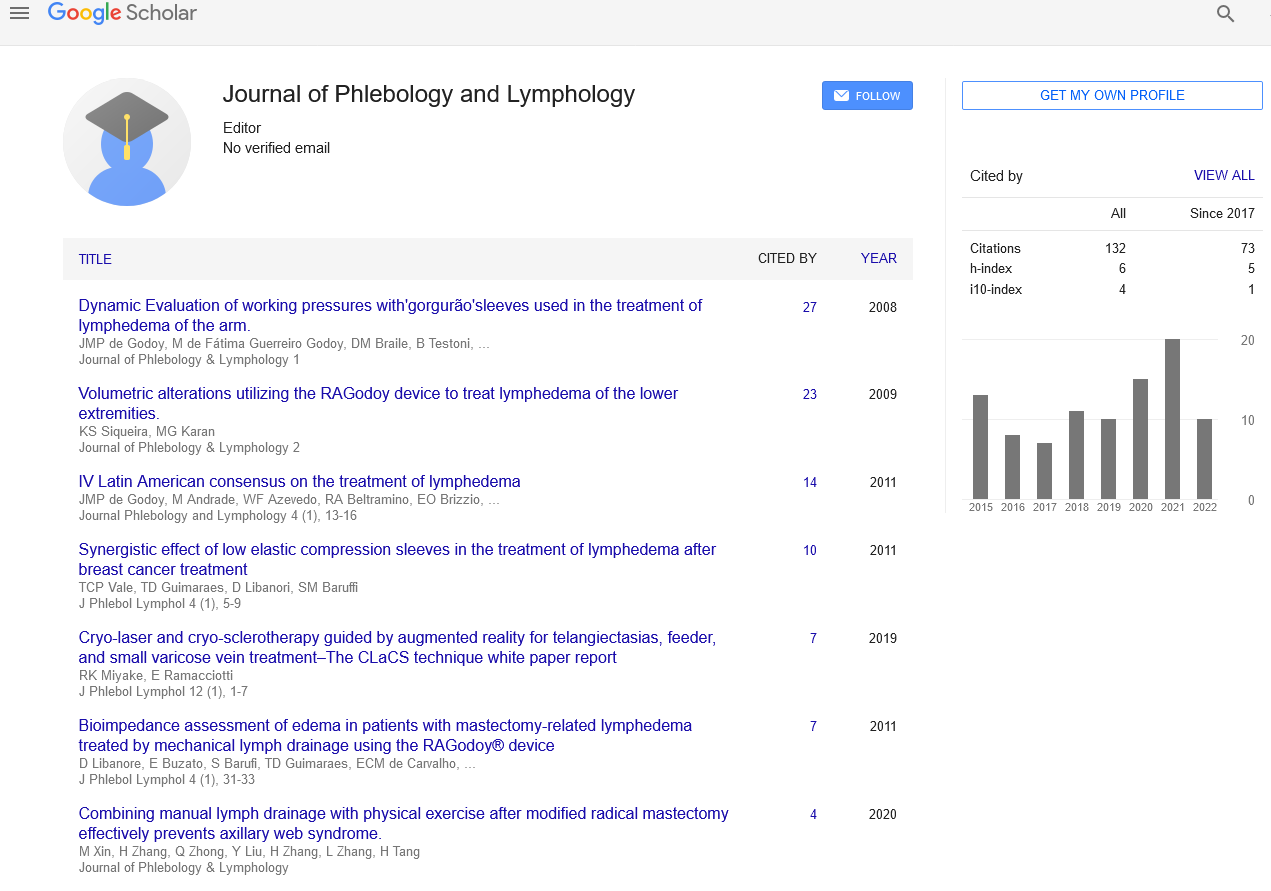a brief guidance on chronic lymphocytic leukemia
Received: 02-Dec-2021 Accepted Date: Dec 10, 2021; Published: 22-Jan-2022
Citation: Shallcross DE (2021) A Brief Guidance on Chronic Lymphocytic Leukemia J Phlebol Lympho. 14(6).
This open-access article is distributed under the terms of the Creative Commons Attribution Non-Commercial License (CC BY-NC) (http://creativecommons.org/licenses/by-nc/4.0/), which permits reuse, distribution and reproduction of the article, provided that the original work is properly cited and the reuse is restricted to noncommercial purposes. For commercial reuse, contact reprints@pulsus.com
Description
Chronic Lymphocytic Leukemia (CLL) is a type of cancer in which the bone marrow makes too many lymphocytes (a type of white blood cell). Early on there are typically no symptoms. Later non-painful lymph node swelling, feeling tired, fever, night sweats, or weight loss for no clear reason may occur. Enlargement of the spleen and low red blood cells (anemia) may also occur. It typically worsens gradually over years. Risk factors include having a family history of the disease. Exposure to Agent Orange and certain insecticides might also be a risk. CLL results in the buildup of B cell lymphocytes in the bone marrow, lymph nodes, and blood. These cells do not function well and crowd out healthy blood cells. CLL is divided into two main types: those with a mutated IGHV gene and those without. Diagnosis is typically based on blood tests finding high numbers of mature lymphocytes and smudge cells [1].
Early-stage CLL in symptomless cases responds higher to careful observation, as there's no proof that early intervention treatment will alter the course of the sickness. Immune defects occur early within the course of CLL and these increase the chance of developing serious infection that ought to be treated fitly with antibiotics. In those with important symptoms, therapy or therapy is also used. As of 2019 ibrutinib is commonly the initial medication counseled. The medications fludarabine, cyclophosphamide, and rituximab were antecedently the initial treatment in people who area unit otherwise healthy. CLL affected regarding 904,000 individuals globally in 2015 and resulted in sixty, 700 deaths. The sickness most ordinarily happens in individuals over the age of fifty. Men area unit diagnosed around double as typically as girls (6.8 to 3.5 ratios). It’s a lot of less common in individuals from Asia. Five-year survival following diagnosing is more or less eighty three within the u. s.. It represents but I Chronicles of deaths from cancer [2].
Most people area unit diagnosed as having CLL supported the results of a routine biopsy that shows a high white vegetative cell count, specifically an outsized increase within the variety of current lymphocytes. These individuals typically haven't any symptoms. Less unremarkably, CLL could gift with enlarged liquid body substance nodes. this is often spoken as little white blood cell malignant neoplastic disease. Less unremarkably the sickness involves lightweight solely when the cancerous cells overwhelm the bone marrow leading to low red blood cells, neutrophils, or platelets. Or there's fever, night sweats, weight loss, and also the person feels tired [3].
CLL is classified with little white blood cell {lymphoma, cancer, malignant neoplastic sickness} (SLL) joined disease with 2 clinical shows. Wherein, with CLL, morbid cells propagate from inside the bone marrow, in SLL they propagate from inside the lymphoid tissue. CLLs are, in just about all cases, preceded by a selected subtype of organism B-cell blood disorder (MBL).
This subtype, termed chronic white blood cell leukemia-type MBL (CLLtype MBL) is A symptomless, indolent, and chronic disorder within which people exhibit a gentle increase within the variety of current B-cell lymphocytes [4].
These B-cells area unit abnormal: they're organism, i.e. made by one ancestral B-cell, and have a number of constant cell marker proteins, body abnormalities, and sequence mutations found in CLL. CLL/SLL MBL comprises 2 groups: low-count CLL/SLL MBL has organism B-cell blood counts of these monoclonal B-cells >5x9/L is diagnosed as having CLL. Low-count CLL/SLL MBL rarely if ever progresses to CLL while high-count CLL/SLL MBL does so at a rate of 1%-2% per year. Thus, CLL may present in individuals with a long history of having high-count CLL/SLL MBL. There is no established treatment for these individuals except monitoring for development of the disorder's various complications (see treatment of MBL complications) and for their progression to CLL [2,4].
Conclusion
Complications include a low level of antibodies in the bloodstream (hypogammaglobulinemia) leading to recurrent infection, warm autoimmune hemolytic anemia in 10%–15% of patients, and bone marrow failure. Chronic lymphocytic leukemia may also transform into Richter's syndrome, the development of fast-growing diffuse large B cell lymphoma, prolymphocytic leukemia, Hodgkin's lymphoma, or acute leukemia in some patients. Its incidence is estimated to be around 5% in patients with CLL. Gastrointestinal (GI) involvement can rarely occur with chronic lymphocytic leukemia. Some of the reported manifestations include intussusception, small intestinal bacterial contamination, colitis, and others. Usually, GI complications with CLL occur after Richter transformation. Two cases to date have been reported of GI involvement in chronic lymphocytic leukemia without Richter's transformation.
References
- Jeltsch M, Tammela T, Alitalo K, et al. Genesis and pathogenesis of lymphatic vessels. Cell Tissue Res. 2003;14(1):69–84.
- Grewal R, Irimie A, Naidoo N, et al. Hodgkin's lymphoma and its association with EBV and HIV infection. Crit Rev Clin Lab Sci. 2018;55(2):102–114.
- Paul JB. Balancing risk and benefit in early-stage classical Hodgkin lymphoma Blood. 2008; 12;131(15):1666-1678.
- McKay P, Fielding P, Evans EG, et al. Guidelines for the investigation and management of nodular lymphocyte predominant Hodgkin lymphoma. Br J Haematol. 2016;172(1):32–43.





